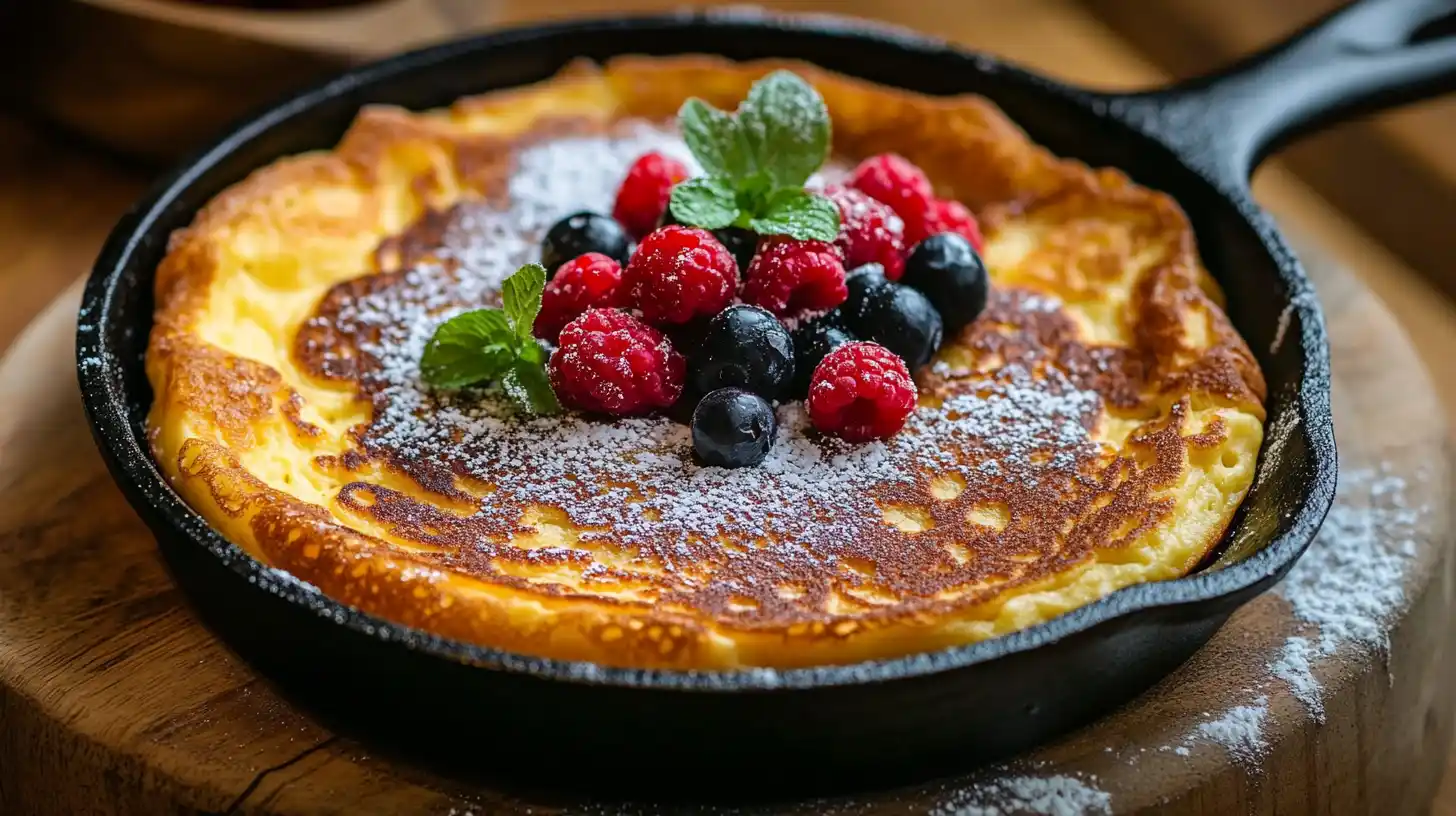Light, airy, and perfectly puffed this German Pancakes recipe is a true breakfast (or brunch) showstopper! Also known as Dutch Babies or oven pancakes, this dish comes together in minutes with just a few pantry staples. No flipping, no fuss just golden, cloud-like deliciousness. Time to whip up some pancake magic!
Table of contents
- Ingredients You’ll Need for German Pancakes
- Step-by-Step: How to Make German Pancakes Recipe
- Expert Tips for German Pancake Recipe Perfection
- Common Mistakes and How to Avoid Them
- Topping Ideas and Serving Suggestions
- German Pancake Recipe Variations to Try
- Why German Pancakes Recipe Are a Perfect Brunch Dish
- Storing and Reheating German Pancakes Recipe
- What to Serve with German Pancakes
- Frequently Asked Questions
- Final Thoughts
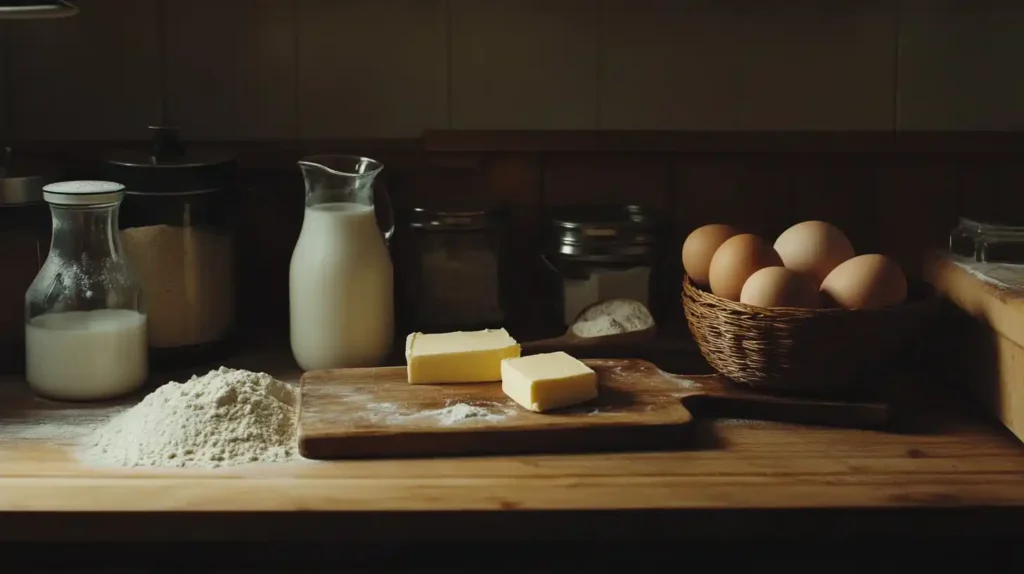
Ingredients You’ll Need for German Pancakes
Here’s the beautiful part you don’t need anything fancy. In fact, you probably already have everything in your kitchen right now.
Basic Ingredients
| Ingredient | Quantity | Notes |
|---|---|---|
| Eggs | 3 large | Room temperature helps puffiness |
| Milk | 1/2 cup | Whole milk preferred for richness |
| All-purpose flour | 1/2 cup | Level it off for accuracy |
| Butter | 2 tablespoons | Unsalted, melted in the skillet |
| Salt | 1/4 teaspoon | Just enough to balance the flavor |
Optional Flavor Boosters
Want to jazz things up? Add these into the batter for a flavorful twist:
- 1 tsp vanilla extract
- Zest of 1 lemon
- 1/4 tsp cinnamon or nutmeg
Adding these isn’t mandatory, but it definitely upgrades the flavor game.
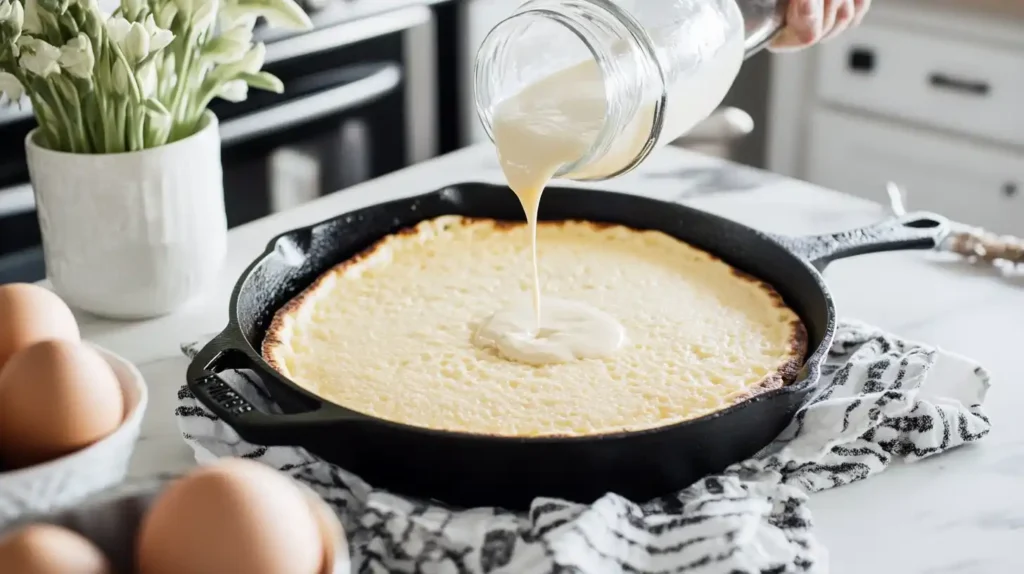
Step-by-Step: How to Make German Pancakes Recipe
Now for the fun part let’s get baking! This process takes less than 30 minutes, and it’s surprisingly satisfying.
Step 1: Preheat Everything
Crank your oven up to 425°F (220°C). You want it hot the heat is what makes the pancake rise like a soufflé. While the oven preheats, place your cast iron skillet or oven-safe dish (around 10-12 inches) inside. Let that pan get nice and toasty.
Step 2: Blend the Batter
While the oven and skillet are heating, grab a blender or whisk:
- Crack in the eggs.
- Add the milk and flour.
- Toss in the salt (and any optional flavors).
- Blend or whisk until completely smooth.
No lumps. No clumps. Just silky batter that pours like heavy cream.
Step 3: Butter, Baby
Carefully remove the hot skillet from the oven. Drop in the butter it should sizzle immediately. Swirl it around to coat the pan. Don’t skip this step it prevents sticking and gives the pancake those crispy edges.
Step 4: Pour and Bake
Quickly pour the batter into the buttered skillet. Get it back into the oven immediately. Now step away no peeking! Let the oven magic happen.
Bake for 18-22 minutes, until the edges are dramatically puffed and golden brown. The center should look set but soft.
Step 5: Serve ASAP
Once it’s done, take it out and serve right away. The puff will start to deflate it’s totally normal, don’t panic!
Top it however you like (more on that later).
Expert Tips for German Pancake Recipe Perfection
Want your German pancake to rise sky-high and taste like a dream? Here are the pro-level secrets that’ll turn you into a breakfast boss:
1. Use Room Temperature Ingredients
Cold eggs and milk are the #1 puff killers. Let them sit out for 30–45 minutes before mixing the batter. This helps the pancake rise better and bake evenly.
2. Preheat the Pan Really Hot
Your skillet or baking dish needs to be screaming hot before you pour in the batter. The sizzle when it hits the pan is a good thing it creates that golden, puffy crust.
3. Blend the Batter Until Smooth
Lumps in the batter can lead to uneven texture. Use a blender or whisk it well until smooth and silky. Then let it rest for 5 minutes to relax the gluten.
4. Don’t Open the Oven Door Early
We know it’s tempting to peek… but don’t! Keep that oven door shut while baking. The trapped heat and steam are what make your pancake rise like a soufflé.
5. Don’t Be Stingy With the Butter
Butter helps prevent sticking and creates those crispy, caramelized edges we all love. Be generous it’s not the time to go low-fat.
6. Use a Smaller Pan for a Taller Puff
The smaller the pan (within reason), the taller your pancake. A 9- or 10-inch skillet is the sweet spot for a sky-high rise.
7. Serve It Immediately
German pancakes start to deflate minutes after coming out of the oven it’s part of the charm! But for the full effect (and Instagram-worthiness), serve it right away.
“German pancakes may be low effort, but with a few smart tweaks, you can make them feel like a bakery masterpiece.”
Common Mistakes and How to Avoid Them
German pancakes are super simple, but like anything with baking and eggs, there’s room for oopsies. Let’s talk about what can go wrong and how you can keep your pancake puffed and perfect.
Why Didn’t My German Pancake Rise?
This is the #1 question people ask and it usually comes down to one of these:
- Cold Ingredients: Eggs and milk straight from the fridge won’t create as much steam. Steam = rise.
- Pan Not Hot Enough: If your skillet isn’t preheated, the batter won’t puff.
- Oven Not Fully Preheated: Same issue you need instant, high heat.
- Using the Wrong Pan: A heavy skillet like cast iron holds heat best.
“Think of the batter like a shy performer it needs the spotlight (aka heat) to show off.”
Rubbery or Too Eggy?
German pancakes are more egg-forward than regular ones, but they shouldn’t taste like scrambled eggs.
Common causes:
- Too many eggs vs. flour (don’t freestyle unless you’ve nailed it before).
- Undercooked center make sure it’s baked through.
- Overmixing the batter use a light touch.
Flat Pancakes or No Puff?
If your pancake came out flat like a crepe, here’s why:
- You opened the oven too early. Let it bake unbothered for the full time.
- Your batter wasn’t smooth lumps mess with texture.
- You used a pan that’s too big the batter spreads too thin.
Batter Consistency Issues
If your batter is too thick, the pancake will be dense and heavy. Too thin, and it might burn or not rise properly.
The sweet spot? Think heavy cream or melted milkshake consistency.
“The batter should pour like a dream, not plop like pancake dough.”
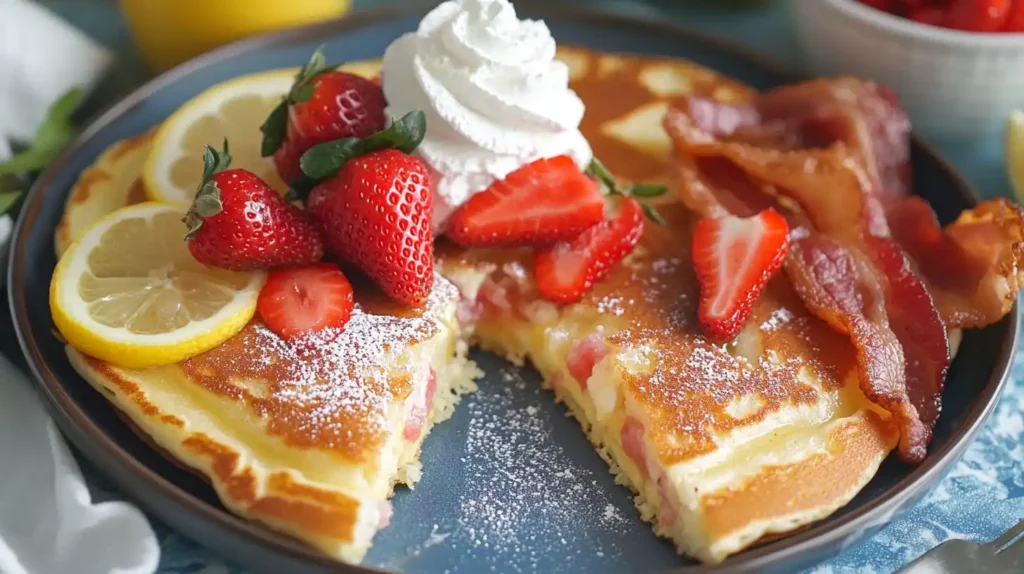
Topping Ideas and Serving Suggestions
Alright, your pancake is hot, puffed, golden, and fresh out of the oven. But don’t stop there now’s the time to level it up with some epic toppings. Whether you’ve got a sweet tooth or you’re craving something savory, German pancakes are like a blank canvas for flavor.
Sweet Toppings: Classics & Creative Combos
Here are some fan-favorite sweet topping ideas to make your pancake extra wow-worthy:
| Topping | Pairing Suggestion |
|---|---|
| Powdered sugar | The OG keep it simple and classy |
| Maple syrup | Drizzle generously for a sweet, sticky touch |
| Fresh berries | Strawberries, blueberries, raspberries |
| Lemon juice + sugar | A tangy-sweet combo that cuts richness |
| Nutella | Rich, chocolatey, and dangerously delicious |
| Caramelized bananas | Try with brown sugar and butter for a twist |
| Cinnamon apples | Like a mini apple pie pancake |
| Whipped cream | Because… why not? |
“German pancakes are like that friend who’s cool with anything sweet, tangy, fruity, even chocolaty. They’re here for it.”
Savory Toppings: Yes, It Works!
Believe it or not, German pancakes don’t have to be sweet. Switch things up with savory toppings, especially if you want a more brunch-y or lunch-y vibe:
- Cheddar & chopped herbs
- Fried egg & avocado slices
- Crumbled bacon or prosciutto
- Sautéed mushrooms with garlic & thyme
- Smoked salmon & cream cheese (seriously!)
Just remember to leave out sugar and cinnamon from the batter if you’re going savory!
German Pancake Recipe Variations to Try
Feeling adventurous? There’s more than one way to puff a pancake! Let’s talk about some awesome variations you can try once you’ve nailed the classic.
Mini German Pancakes (Perfect for Kids or Parties)
Want bite-sized brunch magic? Pour the batter into a greased muffin tin instead of a big skillet. These little puffers bake in about 12-15 minutes and are super fun for kids (and adults with childlike joy).
“Mini German pancakes are like pancake cupcakes cute, golden, and perfect for dunking in syrup.”
Gluten-Free or Dairy-Free Options
No gluten? No problem. Swap out the flour for one of these:
- Gluten-free all-purpose flour blend
- Almond flour (slightly nuttier texture)
- Oat flour (light and fluffy)
For dairy-free, use:
- Almond milk or oat milk
- Vegan butter or coconut oil in place of regular butter
Just keep the ratios the same and you’re golden!
Dutch Baby vs German Pancake Recipe: What’s the Deal?
Okay, so is a German pancake the same as a Dutch Baby?
Basically… yes.
The term Dutch Baby was made popular in the U.S., but it’s really just another name for the same dish. The confusion comes from “Deutsch” (German) being misheard as “Dutch.” The only real difference you might see is presentation Dutch Babies are sometimes served in smaller pans or ramekins, while German pancakes are often made family-style in a big skillet.
Either way, they’re the same delicious puffed-up magic.
Why German Pancakes Recipe Are a Perfect Brunch Dish
Brunch is supposed to be chill, a little fancy, and a lot of fun. And German pancakes recipe check every box. Here’s why they’re brunch superstars:
Easy to Make, Even for a Crowd
You only need a few ingredients and about 5 minutes of actual hands-on work. Want to feed the whole family or impress friends on Sunday morning? Just double or triple the recipe and pop a few pans in the oven. Done and done.
Pairs Beautifully with Brunch Sides
German pancakes recipe go with everything:
- Fresh fruit
- Crispy bacon or sausage
- Mimosas or fresh OJ
- Coffee with cinnamon or vanilla
- Greek yogurt or fruit compote
“Serving German pancakes at brunch is like showing up to a party in a tuxedo and sneakers classy but fun.”
Storing and Reheating German Pancakes Recipe
If you happen to have leftovers (rare, but it happens), don’t toss them! German pancakes can be stored and reheated with great results.
How to Store Leftovers
Let the pancake cool completely before storing. Then:
- Wrap it in plastic wrap or foil
- Store in an airtight container
- Keep in the fridge for up to 3 days
- Or freeze for up to 2 months (slice it first for easier reheating)
Reheating Without Losing Texture
Want it crispy again? Skip the microwave and use the oven or toaster oven.
| Method | Temp | Time | Notes |
|---|---|---|---|
| Oven | 375°F (190°C) | 5-10 minutes | Best for crisp edges |
| Microwave | N/A | 30–45 sec | Fast but loses crispiness |
| Toaster Oven | 375°F | 5 minutes | Great balance of fast & crispy |
Pro tip: Sprinkle a little water on top before reheating in the oven it helps keep the center moist.
What to Serve with German Pancakes
- Chocolate Pound Cake Recipe: A rich, chocolaty side to satisfy any brunch sweet tooth.
- Hawaiian Roll French Toast: Sweet and pillowy soft, perfect alongside pancakes.
- Bahama Mama Tropical Smoothie: Fruity, refreshing, and vacation-vibes approved.
- Cortisol Cocktail Recipe: A wellness drink to kickstart your morning.
Frequently Asked Questions
Why didn’t my German pancakes rise?
Probably because your pan or oven wasn’t hot enough. Also, check that your ingredients were at room temp. Cold milk or eggs can mess with the rise.
What’s the difference between German pancakes and regular pancakes?
Regular pancakes are cooked on a griddle and flipped. German pancakes recipe are baked in the oven and puff up like a popover. They’re also more eggy and custardy than fluffy American-style pancakes.
Can I make German pancakes without a cast iron skillet?
Yep! Any oven-safe dish works like a glass pie dish or even a ceramic casserole. Just make sure it’s well-buttered and preheated.
Are German pancakes supposed to be eggy?
A little bit, yes. They use more eggs than regular pancakes, which gives them a custardy texture. If it tastes too eggy, try adding vanilla, lemon zest, or cinnamon to balance it out.
Final Thoughts
German pancakes recipe aren’t just breakfast they’re an experience. From the dramatic rise in the oven to the endless topping possibilities, this dish brings comfort food with a twist of magic. Whether you’re making a cozy morning for two or impressing guests at brunch, this recipe delivers flavor, fun, and a little wow-factor in every bite.
So go ahead preheat that oven, grab your skillet, and watch your pancake puff like it’s got a personality of its own. Trust me, once you’ve tasted that crispy edge and custardy center, you’ll wonder why you ever settled for regular pancakes.
Now it’s your turn make it, top it, share it, and enjoy every last bite. And don’t be surprised when you start craving it every weekend.
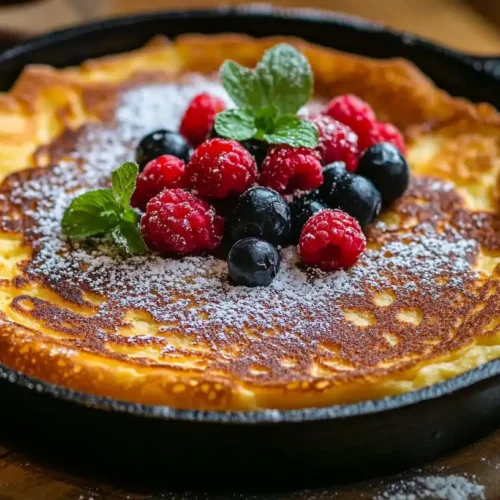
German Pancakes
Equipment
- Oven-safe skillet or cast iron pan
- Blender or whisk
Ingredients
Basic Ingredients
- 3 large eggs room temperature
- 1/2 cup milk whole milk preferred
- 1/2 cup all-purpose flour leveled
- 2 tbsp unsalted butter for the skillet
- 1/4 tsp salt
Optional Flavor Boosters
- 1 tsp vanilla extract optional
- 1 lemon zest zest of one lemon
- 1/4 tsp cinnamon or nutmeg optional
Instructions
- Preheat oven to 425°F (220°C). Place an oven-safe skillet (10-12 inch) inside to heat up.
- In a blender, combine eggs, milk, flour, salt, and any optional flavorings. Blend until smooth.
- Remove hot skillet, add butter, and swirl to coat the bottom and sides completely.
- Quickly pour the batter into the hot skillet and return to the oven immediately.
- Bake for 18–22 minutes until puffed and golden. Do not open the oven early.
- Serve immediately with your favorite toppings. The pancake will deflate slightly—totally normal!

